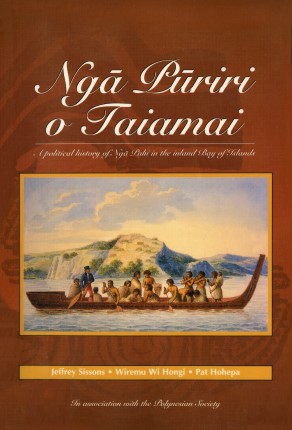
The Pūriri Trees are Laughing: A Political History of Ngā Puhi in the Inland Bay of Islands - Jeffery Sissons, Wiremu Wi Hongi and Pat Hohepa, (1987)

This highly regarded work brings together Ngāpuhi oral traditions and early European accounts of the inland Bay of Islands region. The Pūriri Trees are Laughing presents an essential history of New Zealand’s most populous iwi.
Publication details
Sissons, J., W. W. Hongi and P. W. Hohepa. The Puriri Trees are Laughing: A Political History of Ngā Puhi in the Inland Bay of Islands. Auckland: Penguin, 1987
About the book
The Pūriri Trees are Laughing was first published by the Polynesian Society in 1987 and remains an important record of the political history of Ngāpuhi tribal groups in the Taiamai and Te Waimate regions of the inland Bay of Islands. The authors explain that the title of their work is taken from a well-known Ngāpuhi whakatauakī or saying: Ka kata ngā pūriri o Taiamai (the Pūriri trees of Taiamai are laughing). It is said these words were first spoken by Ngāti Pou after they had been evicted from the Taiamai plains by Ngāpuhi.
The book has three parts: Part one considers political relationships between hāpū (subtribes) in the period 1815 to 1819, drawing upon the accounts of Samuel Marsden in his visits to Te Waimate in 1815 and Taiamai in 1819.
Part two looks back to the beginnings of Ngāpuhi with the founding ancestor Rahiri and traces his descendants over four generations, including a narrative by Wiremu Wi Hongi.
Part three moves on to the second half of the eighteenth century, incorporating seven narratives relating to warfare and conquest at Te Waimate and Taiamai. The narratives are given in Māori with English translations, with introductions and concluding discussions. Illustrated with historic drawings and photographs, The Pūriri Trees are Laughing also features nine maps and thirty-three whakapapa charts.
This book was republished in 2001 by Reed and again in 2008 by Penguin. The 2008 publication has been digitised (see below).
Further information
This publication is part of the series Te Takarangi: Celebrating Māori publications - a sample list of 150 non-fiction books produced by a partnership between Royal Society Te Apārangi and Ngā Pae o te Māramatanga.
